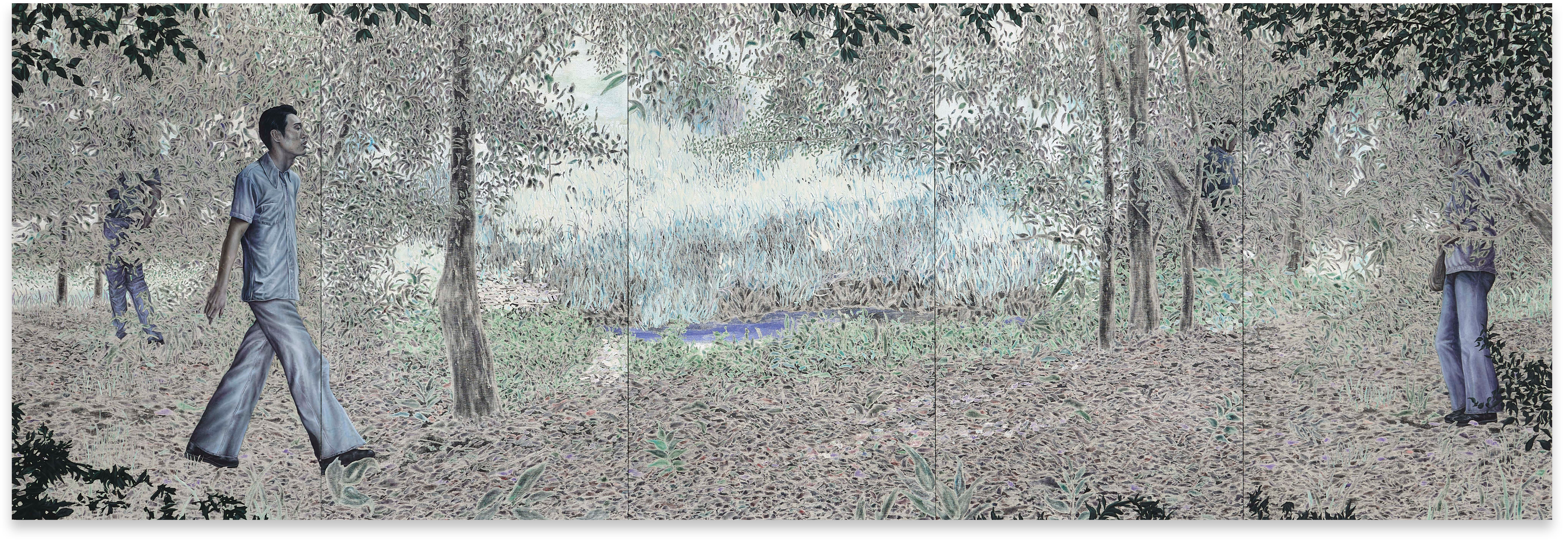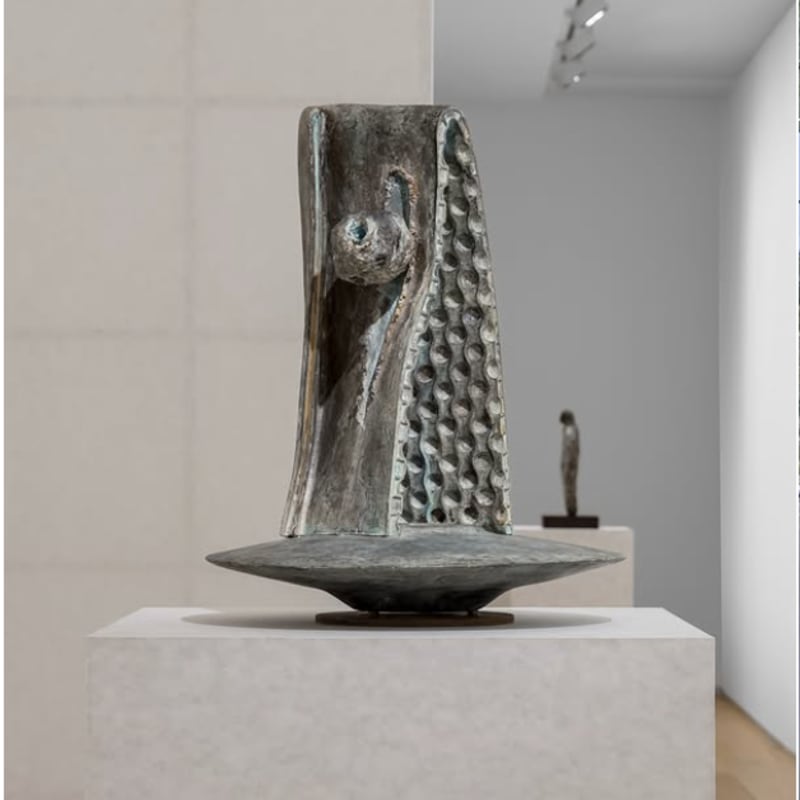
Eva Helene Pade
(b.1997; Odense, Denmark)
Art history stands as a point of departure for Eva Helene Pade and her robust paintings of female figures. Now based in Paris, she responds to a lineage of Northern European figurative artists, including Edvard Munch, James Ensor and Otto Dix, she investigates the complexities of human relationships and the multiplicity of subjectivity in open-ended narratives.
![Eva Helene Pade Blå aften [Blue Evening], 2024 Oil on canvas 180 x 180 cm (70.87 x 70.87 in)](https://artlogic-res.cloudinary.com/w_1400,h_1400,c_limit,f_auto,fl_lossy,q_auto:good/ws-ropac/usr/images/feature_panels/image/6543/ehp.jpg)
Eva Helene Pade
Blå aften [Blue Evening], 2024
Oil on canvas
180 x 180 cm (70.87 x 70.87 in)

Olga Grotova
(b.1986; Chelyabinsk, Russia)
Intergenerational narratives sit at the heart of Olga Grotova’s practice. Based in London, she uncovers overlooked experiences of Soviet and Eastern European women who, like her own German-Soviet family, have been erased from established historical records. In her canvases the body becomes a site through which she pays testament to these absences.
The whole process of my work is not so much representing something, it’s more embodying something via absences and the materials. They enter this narrative and they bring their own narratives with them. — Olga Grotova

Working with cameraless photography, Grotova creates photograms that produce shadow-like traces of her and her mother’s bodies, which are then fragmented in densely layered compositions. Their forms intersect with those of dried flowers and railway maps, as well as natural pigments and soil, all derived from locations directly connected to the histories she tells. Through this process of fragmentation, reassembly and abstraction, Grotova removes hierarchical distinctions between the subject and object to consider how the natural world bears witness to human experience.
Olga Grotova
Her Garden, 2024
Lapis lazuli, natural pigments, hair, photograms and oil on linen
220 x 170 cm (86.61 x 66.93 in)

Dean Fox
(b.1979; London, UK)
Dean Fox renders our perception of the world unfamiliar through his interrogation of the very praxis of painting. For this exhibition, he revisits paintings by the French Post-Impressionists Édouard Vuillard and Paul Gauguin. He composes digital collages that dissect and reassemble elements of the original works in new compositions, which he then translates onto canvas in oil.
Reimagined within his own distinctive painterly language, the alluring works play with perspective to elide distinctions between foreground and background, the human subject and their environment. Just as the Post-Impressionists explored the potential of painting as a technology to replace objective representation with subjective experience, Fox reflects the ever-shifting and unfixed nature of our contemporary world through his intervention in the painterly tradition.
The relationship between the figure and the environment is almost a love affair between the two. The environment points to the figure and the figure in some way points to the environment.
— Dean Fox

YaYa Yajie Liang
(b.1995; Henan, China)
Across the layers of her intricately painted compositions, YaYa Yajie Liang interrogates the enmeshment of the body and its environment on an intimate scale. She depicts the body in metamorphosis. Short, dynamic brushstrokes swirl across the canvases to push and pull the painting between figuration and abstraction, imbuing the works with an inherent sense of movement, as though they are living ecosystems in perpetual transformation.
Based in London, she takes inspiration from the natural world around her. ‘All of my works are from my observations, physical and emotional encounters with the external world,’ she says. ‘I try to transfer the energies I perceive from the earth, the ground, the light, through my way of painting. And the most important of what I feel is from the real things, rather than the imagination.’

For Liang, painting is a collaborative act directed as much by the paint, brush and canvas as her own embodied instincts. Following philosopher Jane Bennett, she conceives of a shared ‘vibrant matter’ that enlivens the world, breaking down binary distinctions between the organic and inorganic, human and animal, self and other, as well as the artist and their materials. Questioning these categories, she fosters queer ecologies that propose alternate ways of being in kinship with the natural world, and how they might be given form through artistic expression.
YaYa Yajie Liang
Our dreaming arms entwine, while the night ascends from within us, 2024
Oil on canvas
220 x 180 cm (86.61 x 70.87 in)

YaYa Yajie Liang
Circle Dance, 2024
Oil on canvas
200 x 160 cm (78.74 x 62.99 in)
— Effie Wanyi Li

Effie Wanyi Li
(b.1995; Shenzhen, China)
Dissolving distinctions between internal and external states of being, working in her London studio Effie Wanyi Li takes up the act of painting to materialise visceral landscapes in which psychological and emotional impulses are entwined with physical sensation. Articulated in fleshy, bruised palettes, biomorphic structures suggest the forms of internal organs, even while they twist and metamorphose into topographical features and floral motifs.

Michael Ho
(b.1991; Arnhem, Netherlands)
Michael Ho locates his interrogation of embodied experience in otherworldly, natural landscapes populated by ghostly figures. He undertakes a physically intense process of pushing acrylic paint through from the back of unprimed canvases to create abstracted leaf-like patterns upon which he articulates his figures in oil paint. Fusing elements of Chinese and European landscape traditions, he describes his forested worlds as ‘liminal’ sites in which to explore East Asian diasporic identities.

Michael Ho
Schatten um Schatten am Rande des Abends [Shadow After Shadow on the Edge of the Evening], 2024
Oil and acrylic on canvas, 5 panels
220 x 650 cm (86.61 x 255.91 in)

Carolina Aguirre
(b.1990; Santiago, Chile)
Interrogating experiences of belonging, Carolina Aguirre brings ambiguous terrains into being using a repertoire of natural inks, shellac and organic pigments. These materials coalesce on the surface of her wood supports to suggest shifting geological landscapes from which body parts and narrative clues emerge and dissolve. Misty imprints of the artist’s own body frame this entanglement of the human and natural worlds within an autoethnographic lens. Working on the floor, Aguirre likens her painting process to ‘excavating’ or ‘gardening’, at times incising directly into the wood panels to cultivate open-ended narratives that hold myriad expressions of belonging and generational memories of migration.
— Carolina Aguirre




![Eva Helene Pade Dansen [The Dance], 2024 Oil on canvas 210 x 300 cm (82.68 x 118.11 in)](https://artlogic-res.cloudinary.com/w_1100,c_limit,f_auto,fl_lossy,q_auto:good/ws-ropac/usr/images/feature_panels/images_and_objects/6481/ehp3.jpg)
![Eva Helene Pade Ekko [Echo], 2024 Oil on canvas 200 x 150 cm (78.74 x 59.06 in)](https://artlogic-res.cloudinary.com/w_1100,c_limit,f_auto,fl_lossy,q_auto:good/ws-ropac/usr/images/feature_panels/images_and_objects/6481/ehp2.jpg)






























































































































































































